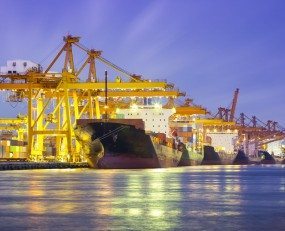
Each year, the Agility Emerging Markets Logistics Index (AEMLI), compiled by Transport Intelligence in partnership with Agility, seeks to answer to that question.
AEMLI, which is published freely around the start of each year, essentially tackles the issue by taking three approaches: a survey of supply chain professionals (offer your thoughts and expertise for this year’s AEMLI here), an assessment of the largest and fastest growing emerging market air and sea trade lanes, and an index which examines the attractiveness of emerging markets according to three main criteria: market size & growth, market compatibility (ease of doing business) and market connectedness (quality of infrastructure).
Last year, the survey of over 800 supply chain professionals found that India, China, Brazil, Vietnam and Indonesia had the most potential to grow as logistics markets over the next five years. This was similar to the year before, as respondents perennially value market size highly, although it is clearly not the whole story. Of the 50 emerging markets considered in the study, Vietnam has the 23rd highest GDP, but ranked 4th highest in potential according to survey respondents, probably on account of its sustained surging trade volumes. Iran was ranked 9th in potential, up from 15th a year ago. It will be interesting to see how it fares this year now that the clamour around it has somewhat died down. The survey also covers topics such as supply chain risk, problems with doing business in emerging markets, the future of free trade and globalisation, Brexit and emerging markets and much more. Overall, it provides insight into a wide range of supply chain issues across emerging markets, helping to assess which countries offer the best logistics opportunities.
Moving on to trade, the first step into an emerging market for an international logistics provider is often through the offer of forwarding services. Over time, providers form closer relationships with agent partners before setting up shop themselves (sometimes by acquiring the partner), then expanding their offering to more complex logistics services.
Taking Myanmar as an example, CEVA opened its first own office in the capital Yangon in June 2017, having previously been operational in the country for five years through a ‘network partner’. Panalpina followed a similar model in 2015, and no doubt many others have done the same over the last decade.
An important part therefore of assessing logistics opportunities in emerging markets is looking at the performance of emerging market air and sea freight trade lanes. The trade lane analysis in AEMLI investigates the tonnage of goods shipped by air and sea between 50 emerging markets and the US and EU, ranking the 10 largest and 25 fastest growing import and export lanes for each mode. The analysis digs deep, identifying the most important commodities on specific trade lanes and what is really driving or holding back growth.
For example, in last year’s AEMLI, the top 10 emerging market air freight export trade lanes to the US/EU included Kenya-EU (3rd highest, 209,000 tonnes), Colombia-US (5th, 166,000 tonnes) and Bangladesh-EU (10th, 88,000 tonnes).
Kenya-EU air freight tonnage is dominated by flowers (around three quarters) and vegetables (about one quarter). While growth was in the low single digits last year, over the longer run, its 2005 to 2016 compound annual growth rate (CAGR) was 10.9%. Panalpina in particular has tapped growth in this lane through a series of acquisitions. For Colombia-US, flowers are also the big story, accounting for about 90% of tonnage. 2016 growth was estimated at 6.1%, though its longer run growth is weaker, with its CAGR at just 2.0%. Bangladesh-EU is a different story, with 2016 growth of over 20% and a long run CAGR of 8.2%. Unsurprisingly, around three quarters of tonnage is accounted for by apparel.
The final way in which AEMLI investigates emerging markets is the Index section itself, which ranks 50 countries on a scale of 0 to 10. Last year, China was top with a score of 7.88, while Mozambique was bottom of the pile with a score of 3.38.
The Index is comprised of three ‘sub-indices’ with the following weightings: market size and growth (50%), market compatibility (25%) and market connectedness (25%). The market size and growth sub-index covers metrics such as GDP, population, GDP forecasts and financial stability. Compatibility is broadly a measure of the ease of doing business, including variables measuring business regulation, foreign direct investment, security threats and so on. Finally, connectedness measures the quality of infrastructure and the efficiency of customs and border controls. Generally, markets with improving prospects are those moving up the index year-on-year.
Last year, Iran was the biggest improver, moving up eight places to rank 18th, as it took steps to reintegrate back into the world economy. When UN sanctions were removed in January 2016, many shippers and logistics providers renewed their interest in the country.
Moving in the opposite direction was Nigeria, which moved down nine places to 24th, as the collapse in oil prices continued to take its toll on the economy, with its economic forecasts slashed. Elsewhere, South Africa fell by four positions to 21st as falling foreign direct investment, stalling infrastructure development and social issues weighed down its score.
Overall, 2016 was another year where optimism around emerging markets was questioned. Clearly, there has been a significant trade bounce in 2017, with several major forwarders reporting first half year-on-year air freight volume growth in excess of 10%. Sea freight volumes have grown healthily too. On this basis, the trade lanes and index portions of AEMLI should deliver a more optimistic message, but as ever, it is up to the industry to give its views through the survey.
Contribute to the 2018 Agility Emerging Markets Logistics Index
The survey is now open and all participants will be the first to receive the index when published as well as being offered the chance to win an iPad.